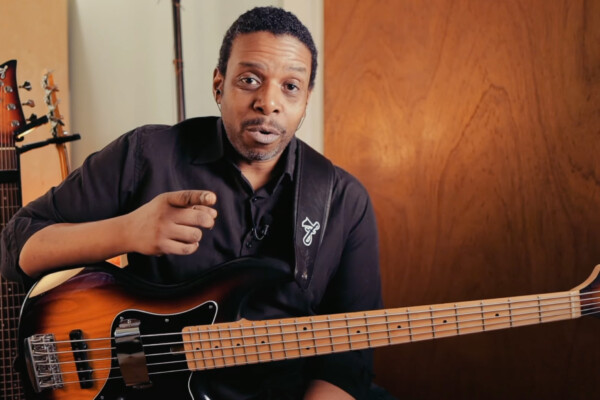Rhythmic Bass Playing: Making it Fit the Musical Setting

Q: For a while, I’ve been focusing on developing a percussive finger style bass technique, in a similar style to yours. I have great fun with it when playing on my or own or looping, but whenever I try it in a band situation, it just never sounds as good. All the detail – and most of the groove – gets lost and I end up reverting back to my usual playing, or slap bass. Am I just being silly for trying to play like this with others, or is there anything (EQ settings, pedals, preamps, compressors, etc.) that can help?
A: Quite often, the effectiveness of techniques like that one come down to dynamics and context.
It can be tricky when you’re figuring out how to use techniques that are somewhat “over-the-top” technically, or even just playing a line that’s busy and not stepping on toes or impacting the music in a negative way.
There are many examples of players who make it work, and many of them make it work because the context of the music they are playing calls for it. Victor Wooten in the Flecktones is a prime example. You’ll notice that in many videos where he is just playing bass with other bands, he really sticks to his role and is a great bass player, without double thumbing everything or over-complicating his part.
Another example might be James Jamerson. He was a very active player but never did anything negative to the song. This is largely due to the fact that he always supported the harmony and was always locked in with the drummer.
You can actually get away with quite a lot if you stick to foundational harmony, keep that groove locked in and play musically.
The first step to utilizing these techniques in a real world context is experimentation. You’re doing that now, and you’re not feeling it yet. So I would recommend recording a few shows so you can analyze your performance. Try and hear what exactly isn’t working, and why.
Generally, for the percussive stuff to work and enhance the music, there have to be a few things in alignment:
- The music must have room for it. There is a time and place for everything.
- The rhythm needs to relate to the music and it needs to be solid. If your time suffers when you do it, it’ll never work It needs to flow.
- Dynamics! It can’t be one volume and have no shape. It needs to sing a little bit.
- It needs to support or enhance the harmonic relationships of what is going on around you. (Speedy pentatonic triplets won’t work over a diminished chord unless you get lucky or are very careful).
So what I would suggest is this:
- Work those techniques through changes. Arpeggios, scale fragments, scales in broken intervals, etc.
- Practice being able to use those techniques over the very same harmonic concepts you employ when not using those techniques
- Practice playing with dynamics.
- While you are working through changes, also practice going from a whisper to a roar and back again. I sometimes practice a four bar swell. I’ll start at a whisper, peak near the beginning of the third bar and then decrescendo back to a whisper by the end of the 4th bar and continue on like that.
- Practice rhythmically like a drummer. Ditch the harmony for 20 minutes (or more) and just play rhythms on one note, to a metronome. Pretend you are a drum core guy or a marching snare. Play different subdivisions (and articulate and dynamic markings). You want to be locked in and one with the drummer when getting hyper-rhythmic so practice like a drummer.
I’d also encourage you to invent your own exercises. Just try to keep thinking of new ways to do things. That’s where the good stuff happens in the shed.
I hope that helps!
Readers, what has worked for you? Please share your thoughts and experiences in the comments!
Have a question for Damian Erskine? Send it to [email protected]. Check out Damian’s instructional books, Right Hand Drive and The Improviser’s Path.




Recording your shows! The best tool for any musician I think! “Practice rhythmically like a drummer” I love it!
Nice concepts! Dynamic playing needs to be rehearsed. Sometimes talking to the band members about these ‘dynamic’ concepts can bring it to the performance on stage. Talk Talk Talk to each other!